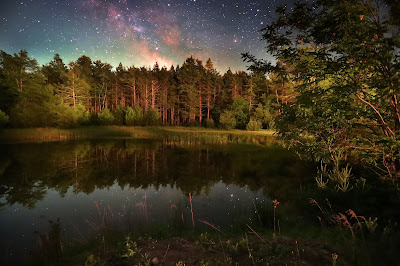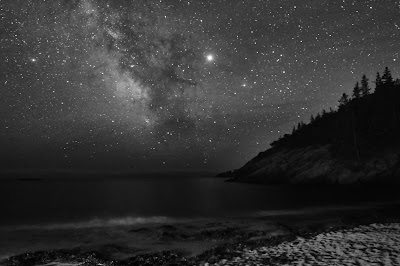On the midnight of September 26, 2025, under the deep African sky, I captured one of the most surreal moments of light and life. The photograph — a 21-image panorama taken with my Canon EOS Ra and Canon EF 200 mm f/2.8L II USM lens (f/3.2, ISO 25 600, 15 s exposure) — reveals the Milky Way arcing like a celestial rainbow above a solitary baobab tree in Tarangire National Park, Tanzania.
 |
| Rainbow of the Milky Way and the Eternal Baobab - Tarangire National Park, Tanzania |
This is a single-night image, stitched in Photoshop, but it carries the weight of millennia — both cosmic and earthly.
The Baobab: The Tree of Life
At the center of the frame stands the baobab (Adansonia digitata), often called the Tree of Life. Native to the dry savannas of sub-Saharan Africa, this extraordinary species grows in scattered populations across Tanzania, Madagascar, and parts of the Sahel. Baobabs can live for over 2 000 years — some carbon-dated specimens have reached 2 500 to 3 000 years old — silently witnessing the passing of generations, civilizations, and climates.
 |
| Baobab |
Their immense trunks, often more than 10 meters in diameter, are actually natural reservoirs; a single tree can hold up to 120 000 liters of water within its fibrous tissue. In the dry season, elephants and baboons are sometimes seen peeling their bark to reach the moisture inside.
In African folklore, the baobab is a sacred symbol — a meeting of heaven and earth. Its branches, reaching skyward like roots, gave rise to legends that the gods planted it upside-down. Standing beside one beneath the Milky Way, the resemblance to a cosmic silhouette feels almost intentional.
Tarangire: The Quiet Heart of the Savanna
Located just south of the equator in northern Tanzania, Tarangire National Park is a sanctuary of vast plains, ancient river valleys, and herds of elephants. Its skies are among the clearest and darkest in East Africa, especially during the dry season from June to October.
That night, around midnight, the air was perfectly still. The southern Milky Way rose high overhead, and the galactic core shimmered in a curtain of color rarely visible to the naked eye.
The Airglow
The subtle green, red, and orange tones in the photo are not from city lights — they are natural airglow, an atmospheric phenomenon that occurs when molecules in the upper atmosphere (about 85–100 km up) emit faint light after being energized by the Sun during the day.
Contrary to popular belief, strong airglow is not limited to the poles; it is often most intense near the equator, where the upper atmosphere experiences greater gravity-wave activity and chemical recombination. Near-equatorial latitudes like Tarangire (~4° S) often produce beautifully structured bands of red (from oxygen at ~90 km) and green (from oxygen at ~95 km) that shimmer across the night sky — invisible to human eyes but captured vividly in long-exposure astrophotography.
What you see above the baobab, therefore, is not light pollution but the Earth itself glowing, whispering its quiet luminescence into the darkness.
A Meeting of Earth and Sky
This image is a meeting of contrasts: an ancient tree rooted in the soil of Africa, and a galaxy 100 000 light-years across suspended above it. Between them, a living, breathing layer of atmosphere paints the bridge — the airglow, the breath of our planet.
 |
| Under the Milky Way: A Night in Tarangire |
Every color in the image tells a story:
- Amber and red: oxygen recombining high above the equator.
- Soft green: the pulse of Earth’s upper atmosphere.
- Silver stars: the spiral arm of the Milky Way.
- Dark silhouette: a 1 000-year-old baobab tree watching the cosmos turn.
In that moment, Tarangire was not just a national park — it was a reminder that the planet itself participates in the night sky.
Technical Notes
- Camera: Canon EOS Ra (modified for astrophotography)
- Lens: Canon EF 200 mm f/2.8L II USM
- Settings: f/3.2 · 15 s · ISO 25 600
- Panorama: 21 frames combined in Adobe Photoshop
- Date: September 26, 2025
- Location: Tarangire National Park, Tanzania (~4° S latitude)
Reflection
When I look at this photograph, I see time itself — the timeless patience of the baobab and the ceaseless motion of the stars. Both are survivors: one through endurance, the other through orbit.
Under that rainbow Milky Way, I realized that the Earth doesn’t just reflect the universe — it participates in it. The light that touched the baobab that night had traveled for tens of thousands of years, only to meet the glow of our own atmosphere.















































